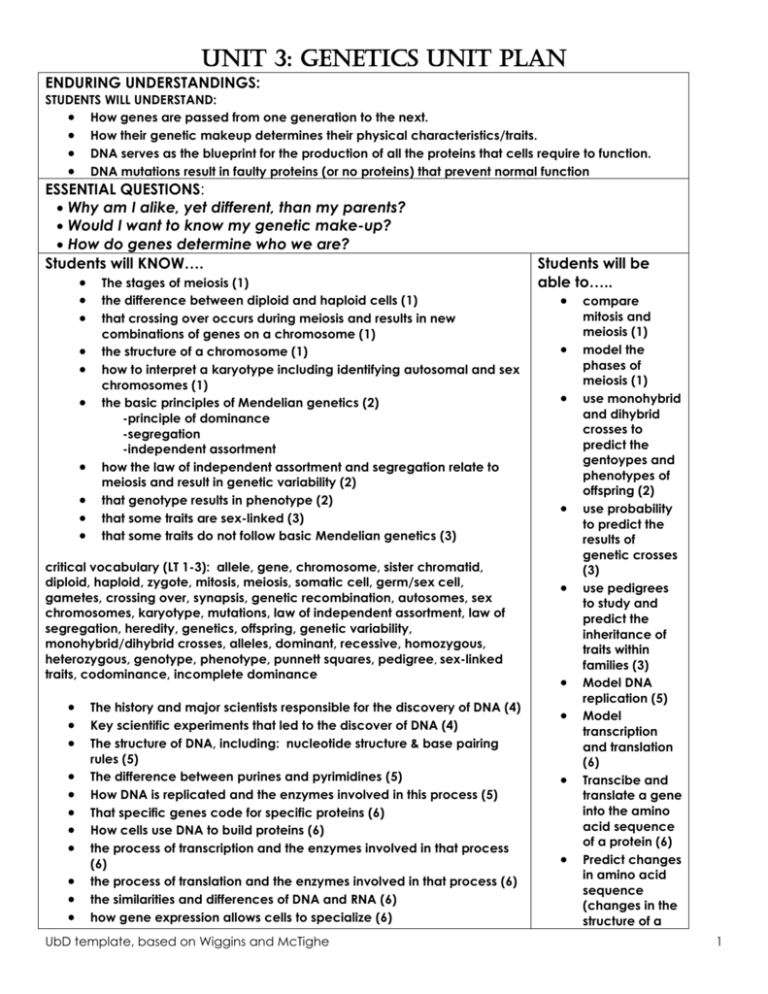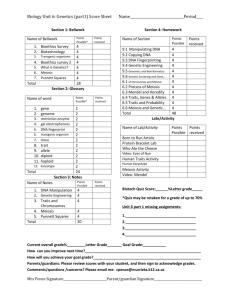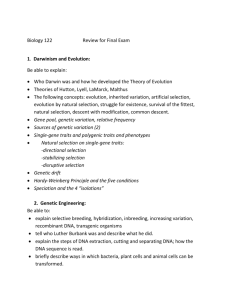GENETICS Ubd unit plan
advertisement

Unit 3: GENETICS unit plan ENDURING UNDERSTANDINGS: STUDENTS WILL UNDERSTAND: How genes are passed from one generation to the next. How their genetic makeup determines their physical characteristics/traits. DNA serves as the blueprint for the production of all the proteins that cells require to function. DNA mutations result in faulty proteins (or no proteins) that prevent normal function ESSENTIAL QUESTIONS: Why am I alike, yet different, than my parents? Would I want to know my genetic make-up? How do genes determine who we are? Students will KNOW…. The stages of meiosis (1) the difference between diploid and haploid cells (1) that crossing over occurs during meiosis and results in new combinations of genes on a chromosome (1) the structure of a chromosome (1) how to interpret a karyotype including identifying autosomal and sex chromosomes (1) the basic principles of Mendelian genetics (2) -principle of dominance -segregation -independent assortment how the law of independent assortment and segregation relate to meiosis and result in genetic variability (2) that genotype results in phenotype (2) that some traits are sex-linked (3) that some traits do not follow basic Mendelian genetics (3) critical vocabulary (LT 1-3): allele, gene, chromosome, sister chromatid, diploid, haploid, zygote, mitosis, meiosis, somatic cell, germ/sex cell, gametes, crossing over, synapsis, genetic recombination, autosomes, sex chromosomes, karyotype, mutations, law of independent assortment, law of segregation, heredity, genetics, offspring, genetic variability, monohybrid/dihybrid crosses, alleles, dominant, recessive, homozygous, heterozygous, genotype, phenotype, punnett squares, pedigree, sex-linked traits, codominance, incomplete dominance The history and major scientists responsible for the discovery of DNA (4) Key scientific experiments that led to the discover of DNA (4) The structure of DNA, including: nucleotide structure & base pairing rules (5) The difference between purines and pyrimidines (5) How DNA is replicated and the enzymes involved in this process (5) That specific genes code for specific proteins (6) How cells use DNA to build proteins (6) the process of transcription and the enzymes involved in that process (6) the process of translation and the enzymes involved in that process (6) the similarities and differences of DNA and RNA (6) how gene expression allows cells to specialize (6) UbD template, based on Wiggins and McTighe Students will be able to….. compare mitosis and meiosis (1) model the phases of meiosis (1) use monohybrid and dihybrid crosses to predict the gentoypes and phenotypes of offspring (2) use probability to predict the results of genetic crosses (3) use pedigrees to study and predict the inheritance of traits within families (3) Model DNA replication (5) Model transcription and translation (6) Transcibe and translate a gene into the amino acid sequence of a protein (6) Predict changes in amino acid sequence (changes in the structure of a 1 how DNA mutations affect an organism (6) Critical Vocabulary (LT 4-6): deoxyribonucleic acid, ribonucleic acid, nitrogenous base, nucleotide, mutation, gene, double helix, protein synthesis, transcription, translation, codon, anticodon, tRNA (transfer), mRNA (messenger), ribosomes, amino acids, purine, pyrimidine protein) based on the type of DNA mutation. (6) LEARNING TARGETS: How are parental genes passed on to their offspring? 1. Chromosomes and Meiosis How can we predict which genes we inherit? 2. Mendel’s Laws of Inheritance and Patterns of Inheritance 3. Non-Mendelian Patterns of Inheritance and Pedigrees How did we learn about DNA and genes? 4. History of DNA How does the structure of DNA allow it to be used as the genetic code? 5. DNA Structure and Replication How do genes determine our traits? 6. Protein Synthesis Assessment/Performance Task Quiz for each LT Two Tests: LT 1-3 and LT 4-6 Genetics Unit Project UbD template, based on Wiggins and McTighe 2









